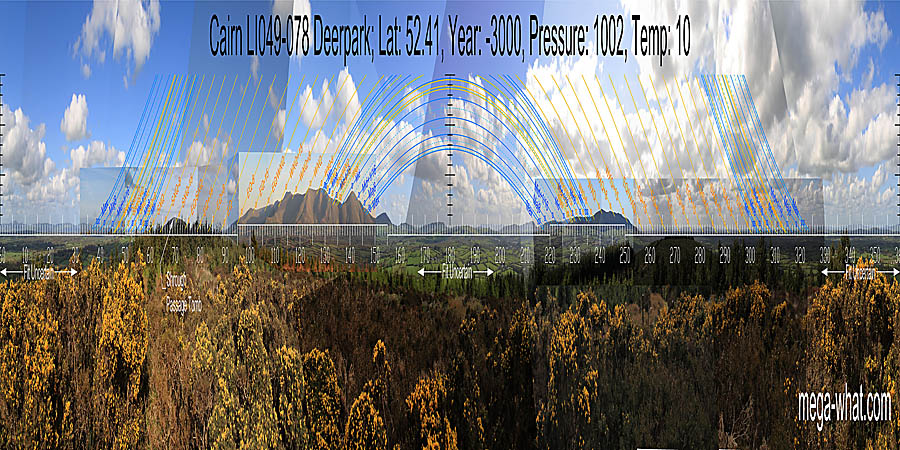 Ó'Nualláin & Cody (1987:82) observed that "The hilltop siting of a mound on the summit of Duntryleague Hill above the cruciform tomb in the same townland
may also be significant in a Passage Tomb context." The relationship between the two sites is instructive.
Ó'Nualláin & Cody (1987:82) observed that "The hilltop siting of a mound on the summit of Duntryleague Hill above the cruciform tomb in the same townland
may also be significant in a Passage Tomb context." The relationship between the two sites is instructive.
South is in a dip from the Cairn [Pic] and from the Tomb [Pic].
North is roughly indicated by an intersection of far and distant horizons from the Cairn [Pic] and from the Tomb [Pic].
 The position of the cairn gives views to the east and south-east that are not obtainable from the tomb itself which is lower down, 188m to the WNW (287°) and on a slight northerly slope.
Shrough Passage Tomb is visible on top of Slievenamuck, two diameters or so
north of the half-month bracket for the summer cross-quarter which is marked by a break/dip in the ridge.
The position of the cairn gives views to the east and south-east that are not obtainable from the tomb itself which is lower down, 188m to the WNW (287°) and on a slight northerly slope.
Shrough Passage Tomb is visible on top of Slievenamuck, two diameters or so
north of the half-month bracket for the summer cross-quarter which is marked by a break/dip in the ridge.
Sliabh na Mban (Slievenamon) is prominent to the east and the equinox is accurately marked by a large step at its south base. Then the Galty Mountains form a useful scale for measuring the winter half of the year and the minor half of the lunisticeLunistices are the most northerly and southerly moons of the month. The lunar equivalent of solstices - more. range.
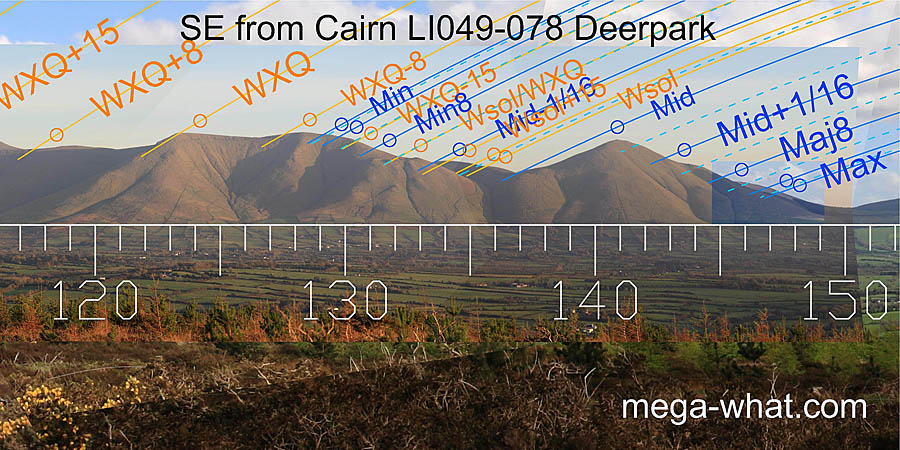 The winter cross-quarters are particularly good as the sun rise follows the slope, giving a high level of precision.
The winter solstice and its half-month bracket are also well marked by sharp notches.
At mid-cycle, the moon rises centrally in the prominent notch and is something over a half-diameter clear of the horizon at the top of the slope.
On the other side of Temple hill, the major limit of the lunisticeLunistices are the most northerly and southerly moons of the month. The lunar equivalent of solstices - more.
range is also well marked [Enlargement].
Notably however, this location does not offer accurate indicators for the sixteenth beyond the lunar midpoint or the major eighth.
The winter cross-quarters are particularly good as the sun rise follows the slope, giving a high level of precision.
The winter solstice and its half-month bracket are also well marked by sharp notches.
At mid-cycle, the moon rises centrally in the prominent notch and is something over a half-diameter clear of the horizon at the top of the slope.
On the other side of Temple hill, the major limit of the lunisticeLunistices are the most northerly and southerly moons of the month. The lunar equivalent of solstices - more.
range is also well marked [Enlargement].
Notably however, this location does not offer accurate indicators for the sixteenth beyond the lunar midpoint or the major eighth.
 From the tomb, local ground cuts off most of the eastern view but the local hilltop is fitted into the pattern.
There is an approximate symmetry between this hilltop and the western ridge end.
From the tomb, local ground cuts off most of the eastern view but the local hilltop is fitted into the pattern.
There is an approximate symmetry between this hilltop and the western ridge end.
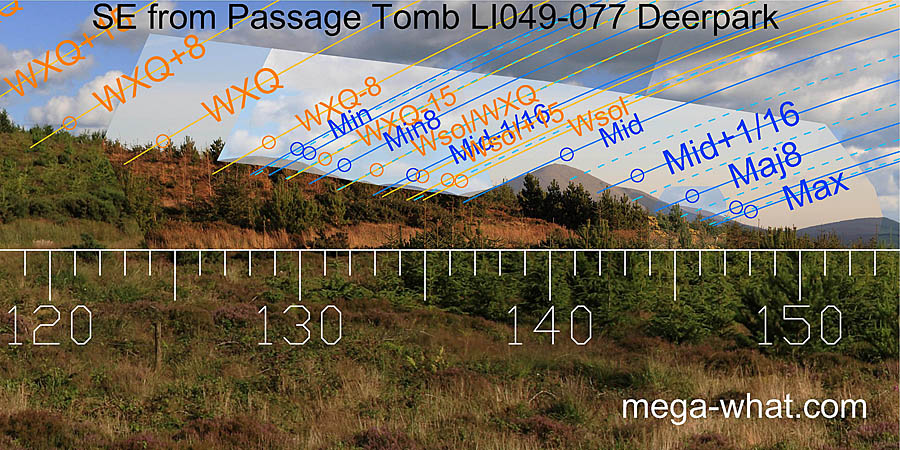 Further south-eastwards, the far horizon starts to become visible but trees now interfere with the view.
Just how much of the far hills should be visible above the local horizon is uncertain but would in any case depend on exact observer position.
It looks as though the winter cross-quarter should be at the near/far intersect and then the hilltop that marks minor
standstillLunistice positions vary cyclically over an 18.6 year period but are fairly static for more than a year at either end of the range
is definitely visible.
The lunar mid-cycle lunisticeLunistices are the most northerly and southerly moons of the month. The lunar equivalent of solstices - more.
rises up the eastern slope of Temple Hill so that it is only just clear of the horizon at the top of the slope.
Further south-eastwards, the far horizon starts to become visible but trees now interfere with the view.
Just how much of the far hills should be visible above the local horizon is uncertain but would in any case depend on exact observer position.
It looks as though the winter cross-quarter should be at the near/far intersect and then the hilltop that marks minor
standstillLunistice positions vary cyclically over an 18.6 year period but are fairly static for more than a year at either end of the range
is definitely visible.
The lunar mid-cycle lunisticeLunistices are the most northerly and southerly moons of the month. The lunar equivalent of solstices - more.
rises up the eastern slope of Temple Hill so that it is only just clear of the horizon at the top of the slope.
The steps on the western slope provide accurate markers for the major half of the lunisticeLunistices are the most northerly and southerly moons of the month. The lunar equivalent of solstices - more. range, thus showing the significance of the difference in position of the two monuments. The major limit of the lunisticeLunistices are the most northerly and southerly moons of the month. The lunar equivalent of solstices - more. range is also marked by the same step in the slope but there is a southerly shift so that the point marking the standstillLunistice positions vary cyclically over an 18.6 year period but are fairly static for more than a year at either end of the range from the cairn marks the sixteenth from the tomb [Enlargement].
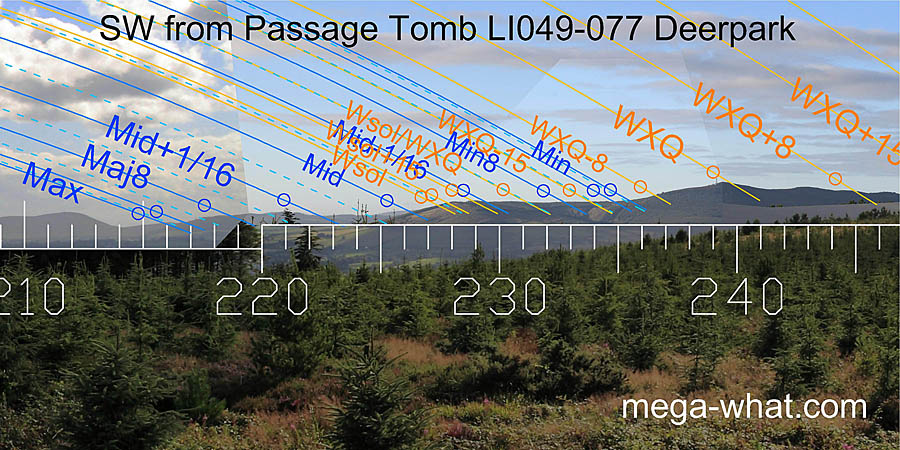 To the south-west, from the tomb, the major end of the lunisticeLunistices are the most northerly and southerly moons of the month. The lunar equivalent of solstices - more.
range is obscured by trees but the remainder is well marked.
The lunar midpoint occurs at the intersect of distant and nearer horizons, the winter cross-quarters are at the pointed hilltop known as "The Pinnacle"
and the minor standstillLunistice positions vary cyclically over an 18.6 year period but are fairly static for more than a year at either end of the range
is at its basal step.
To the south-west, from the tomb, the major end of the lunisticeLunistices are the most northerly and southerly moons of the month. The lunar equivalent of solstices - more.
range is obscured by trees but the remainder is well marked.
The lunar midpoint occurs at the intersect of distant and nearer horizons, the winter cross-quarters are at the pointed hilltop known as "The Pinnacle"
and the minor standstillLunistice positions vary cyclically over an 18.6 year period but are fairly static for more than a year at either end of the range
is at its basal step.
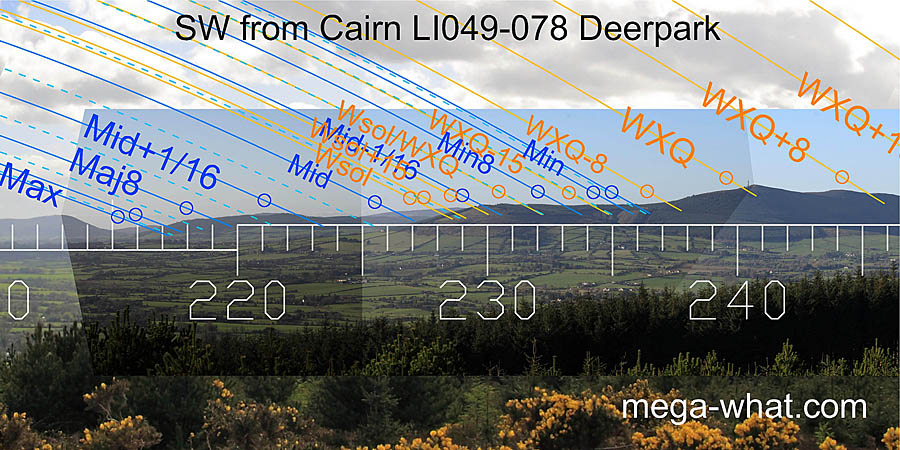 From the cairn, the lunar midpoint and major eighth lack the good markers they had from the tomb but there are also useful differences.
The far/near intersect now marks the solstitial half-month bracket and the basal step of the hill has become a quarter-month bracket for the cross-quarter.
The cross-quarter itself is still marked by the "Pinnacle" but the upper limb this time and
with more of Slievereagh visible from here a good half-month bracket north of the cross-quarter may be found on the final hilltop of the ridge.
From the cairn, the lunar midpoint and major eighth lack the good markers they had from the tomb but there are also useful differences.
The far/near intersect now marks the solstitial half-month bracket and the basal step of the hill has become a quarter-month bracket for the cross-quarter.
The cross-quarter itself is still marked by the "Pinnacle" but the upper limb this time and
with more of Slievereagh visible from here a good half-month bracket north of the cross-quarter may be found on the final hilltop of the ridge.
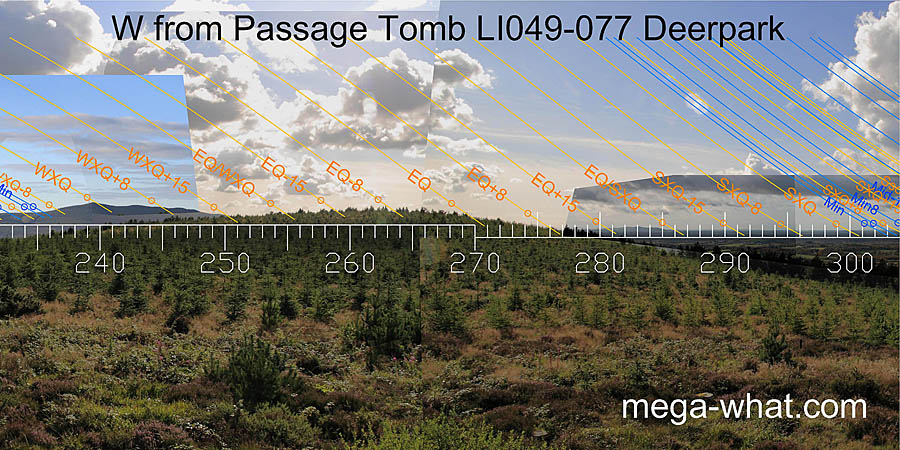 Westwards from the tomb, the half-month bracket for the cross-quarter would be two diameters north of the intersection of distant and local horizons.
The visible end of Duntryleague hill is a quarter-month south of the equinox and the half-month north of the equinox is a couple of diameters
from the local/far intersect, at the south base of a mid-distance hill.
Westwards from the tomb, the half-month bracket for the cross-quarter would be two diameters north of the intersection of distant and local horizons.
The visible end of Duntryleague hill is a quarter-month south of the equinox and the half-month north of the equinox is a couple of diameters
from the local/far intersect, at the south base of a mid-distance hill.
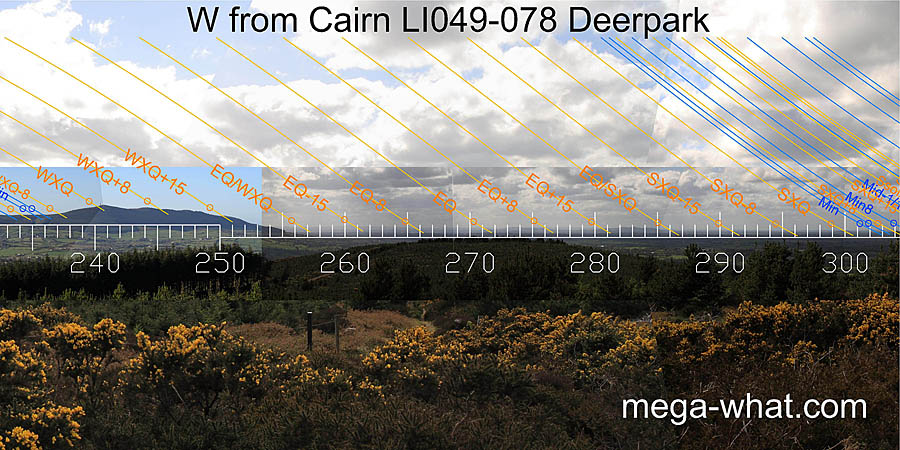 From the cairn, the whole of the distant western horizon is visible.
The half-month north of the equinox is in the same place as from the tomb but its partner the half-month south of the equinox
also has a good mark on a hilltop and the equinox sunset would itself be over the end of the local hilltop.
From the cairn, the whole of the distant western horizon is visible.
The half-month north of the equinox is in the same place as from the tomb but its partner the half-month south of the equinox
also has a good mark on a hilltop and the equinox sunset would itself be over the end of the local hilltop.
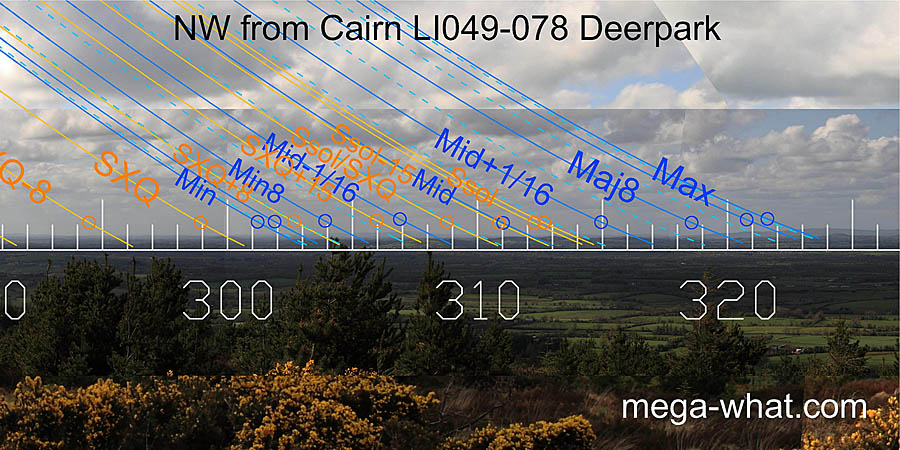 The north-west is basically the same from both sites though very slightly better from the tomb.
The period from summer cross-quarter to solstice is indicated by a series of hills in the middle distance that do not quite cut the far horizon.
Between these and barely visible through the haze is Slievecallan, almost 80km away, the top of which is slightly more than a half-month from the cross-quarter, marking a lunar sixteenth.
The north-west is basically the same from both sites though very slightly better from the tomb.
The period from summer cross-quarter to solstice is indicated by a series of hills in the middle distance that do not quite cut the far horizon.
Between these and barely visible through the haze is Slievecallan, almost 80km away, the top of which is slightly more than a half-month from the cross-quarter, marking a lunar sixteenth.
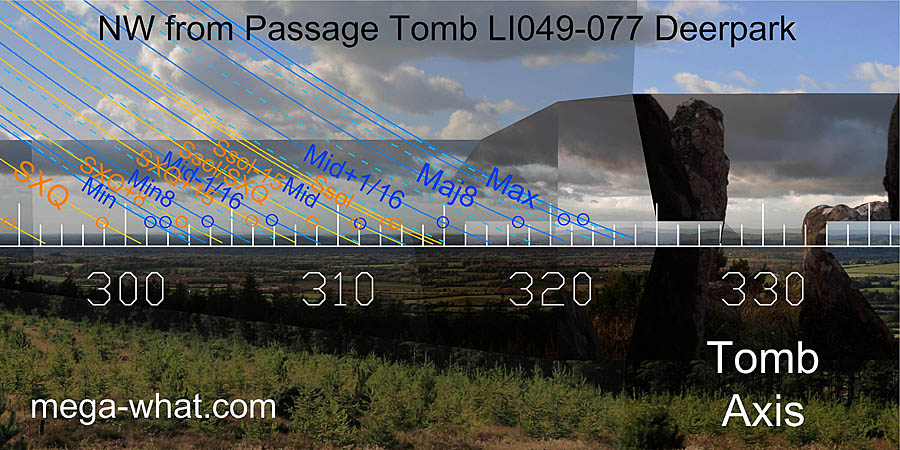 The major end of the lunisticeLunistices are the most northerly and southerly moons of the month. The lunar equivalent of solstices - more.
range falls on a slope [Enlargement]
and the major eighth, its lower limb marked by a step, is also effectively delimited by thirtysecondths.
The tomb's passage orientation is about 328°-335° which is beyond the lunar limit - perhaps this is an early manifestation of the tendency
noted in the Bronze Age Cork-Kerry Complex for an axis indicating the direction of lunar standstillLunistice positions vary cyclically over an 18.6 year period but are fairly static for more than a year at either end of the range
to be exaggerated
when the lunar limit does not have an obvious marker but the reverse axis is towards major standstillLunistice positions vary cyclically over an 18.6 year period but are fairly static for more than a year at either end of the range
in the south-east.
The major end of the lunisticeLunistices are the most northerly and southerly moons of the month. The lunar equivalent of solstices - more.
range falls on a slope [Enlargement]
and the major eighth, its lower limb marked by a step, is also effectively delimited by thirtysecondths.
The tomb's passage orientation is about 328°-335° which is beyond the lunar limit - perhaps this is an early manifestation of the tendency
noted in the Bronze Age Cork-Kerry Complex for an axis indicating the direction of lunar standstillLunistice positions vary cyclically over an 18.6 year period but are fairly static for more than a year at either end of the range
to be exaggerated
when the lunar limit does not have an obvious marker but the reverse axis is towards major standstillLunistice positions vary cyclically over an 18.6 year period but are fairly static for more than a year at either end of the range
in the south-east.
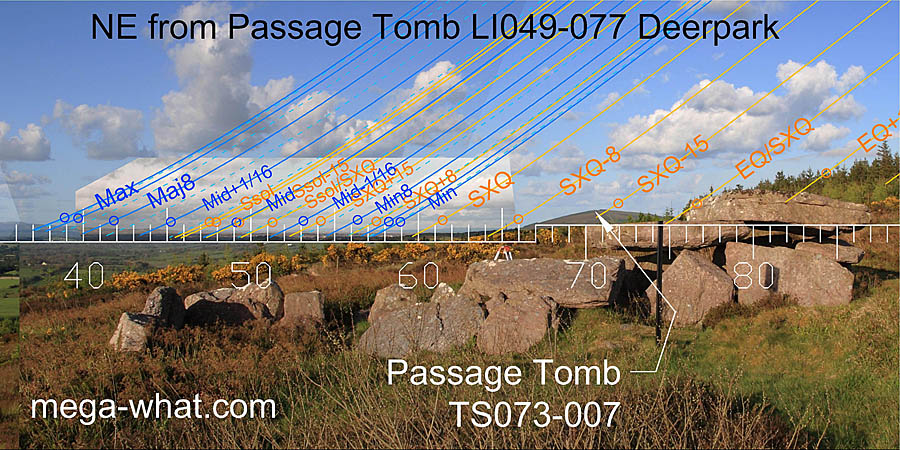 North-eastwards from the tomb, Shrough Passage Tomb on top of Slievenamuck is visible, 6.66km away,
about one diameter north of the half-month bracket for the summer cross-quarter which does not have a good mark from here as it does from the cairn.
North-eastwards from the tomb, Shrough Passage Tomb on top of Slievenamuck is visible, 6.66km away,
about one diameter north of the half-month bracket for the summer cross-quarter which does not have a good mark from here as it does from the cairn.
The local hill then obscures views to the east but its top is about a half-month south of the equinox. The distant north-east horizon is the same from both sites though perhaps marginally better from the tomb. The major eighth occurs on a slope, delimited top and bottom by lunar thirtysecondths. the lunar minor eighth is on the top of a distant hill that is barely visible through the haze, and the minor end of the lunisticeLunistices are the most northerly and southerly moons of the month. The lunar equivalent of solstices - more. range is at its southern foot.
 To summarise, the cairn has the best all round views and in particular is more useful to the east and south-east though the tomb is positioned to give a good major eighth to the south-east.
Views to the south-west are similar but complementary with the cairn giving more solar positions while the tomb once again gives a better major eighth.
Both the north-east and north-west horizons are distant and so the declination differences are small, about 0.1°, with the tomb giving the better fit.
In both these directions the major eighth is effectively delimited by thirtysecondths.
The tomb is also positioned so that the local hilltops, east and west, usefully fit the solar cycle.
To summarise, the cairn has the best all round views and in particular is more useful to the east and south-east though the tomb is positioned to give a good major eighth to the south-east.
Views to the south-west are similar but complementary with the cairn giving more solar positions while the tomb once again gives a better major eighth.
Both the north-east and north-west horizons are distant and so the declination differences are small, about 0.1°, with the tomb giving the better fit.
In both these directions the major eighth is effectively delimited by thirtysecondths.
The tomb is also positioned so that the local hilltops, east and west, usefully fit the solar cycle.
A similar relationship between cairn and tomb may be found at Farnoge Court Tomb in Kilkenny.
- Knockroe Passage Tomb is about 56km to the east, beside another tributary of the River Suir.
References
- Archaeological Survey of Ireland, record details. www.archaeology.ie/archaeological-survey-ireland
- DE VALERA, RUAIDHRÍ & Ó'NUALLÁIN, SEÁN 1982 Survey of the Megalithic Tombs of Ireland, Volume IV: Cork, Kerry, Limerick and Tipperary. Dublin: Stationary Office. p101.
- HERITY, M. 1974 Irish Passage Graves. Dublin: Irish University Press. p262.
- Ó'NUALLÁIN, SEÁN & CODY, EAMON 1987 Passage Tombs in the Suir Valley Region. Journal of the Royal Society of Antiquaries of Ireland 117:69-83, 78-81.
